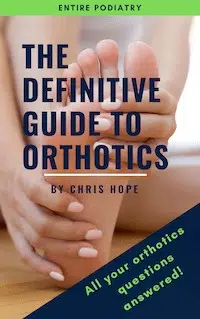Plantar Plate Dysfunction (also known as Plantar Plate Tear, Plantar Plate Insufficiency or Plantar Plate Injury) is one of the most common causes of pain in the ball of the foot, though it’s a condition many people haven’t heard of. In this article, we will explain more about plantar plate dysfunction, the causes, the treatment and how you can help to prevent it.
What is a plantar plate?
A plantar plate is a thick fibrocartilaginous or ligamentous structure. In the foot, plantar plates connect each of the metatarsals to the corresponding proximal phalange of each toe.
Plantar plates have a key role in stabilising the metatarsophalangeal (MTP) joints, allowing the foot to withstand the tensile and compressive loads associated with weight-bearing, and to resist excessive dorsiflexion and hyperextension of the MTP joints.
Plantar plate dysfunction is sometimes also referred to as pre-dislocation syndrome. If allowed to progress, this condition can lead to subluxation or dislocation of the involved joint. Due to the role of the plantar plate in stabilising the MTP joints, people with plantar plate dysfunction will often also have a painful hammertoe.
What does plantar plate dysfunction feel like?
People with plantar plate dysfunction will typically feel pain in the ball of the foot, under the affected MTP joint. There may also be swelling. The joint may be dorsiflexed in relaxed standing, and additional dorsiflexion may exacerbate pain further.
Often plantar plate tear may result in splaying and/or clawing of the toes (as in hammertoe).
Other conditions that also cause ball of foot pain and present with similar symptoms to plantar plate dysfunction include neuroma or sesamoiditis. Capsulitis is a similar condition that can be a precursor to plantar plate tear.
What causes plantar plate dysfunction or tear?
Although this condition can occur in any of the MTP joints and often affects multiple joints, the second metatarsal joint (base of the 2nd toe) is most commonly affected by plantar plate dysfunction. A few factors have been proposed to explain this:
- Plantar plate dysfunction is frequently associated with a hallux valgus deformity (commonly known as a bunion), whereby the big toe angles in toward the second toe. A hallux valgus deformity can cause abnormal forefoot loading patterns, contributing to a repetitive-type injury to the plantar plate of the 2nd toe.
Other factors contributing to abnormal loading of the plantar plate at this point include excessive pronation, and the comparatively longer length of the second metatarsal. - Certain types of footwear, such as high-heeled shoes, can increase vertical peak pressures under the second toe, and some sports have also been implicated in the development of plantar plate inflammation.
- In addition to repetitive injury, plantar plate dysfunction can also be the result of a single traumatic event causing disruption to this structure.
What is the treatment for plantar plate dysfunction or tear?
The effectiveness of conservative treatment depends on the stage of plantar plate dysfunction and degree of symptoms. In general, review of activity and avoidance of high-heeled shoes are important initial measures. In addition, the use of anti-inflammatory agents (topical or oral), compression and ice can help to reduce swelling and pain.
Sling padding or tape strapping the affected toe can give immediate pain relief in some patients, and can help to support a diagnosis of plantar plate dysfunction. In the early stages, tape strapping can be helpful in preventing progression of the condition and subsequent dislocation.
Your podiatrist may also provide some footwear modification in the form of padding and/or orthotics to minimise weight-bearing forces on the area and to optimise foot position. If you have any calluses that may be exacerbating discomfort, your podiatrist can debride these for further symptom relief.
Is surgery required for plantar plate dysfunction?
At times, plantar plate injuries require surgical repair, and other corrections such as hammertoe or tendon repairs may also be performed simultaneously. Specialist surgical review may be undertaken to provide advice on the most appropriate procedure for your circumstances.
Following surgery, a period of reduced weight-bearing is necessary for up to 6 weeks. There are potential complications associated with surgery for plantar plate injury, although in many cases the procedure is successful. Be sure to discuss any potential risks with your surgeon to ensure you have a good understanding of what is involved.
How can I prevent plantar plate injury?
Prevention of plantar plate injury is focused on optimising foot function and minimising abnormal stresses to the plantar plates of the foot. Your podiatrist can conduct a thorough biomechanical assessment and provide advice with regard to footwear and orthotics to reduce your risk of plantar plate dysfunction.
References:
Camasta, C. A. Emerging Concepts In Plantar Plate Repair. Podiatry Today. February 2015; 28(2). Available at: https://www.podiatrytoday.com/emerging-concepts-plantar-plate-repair






